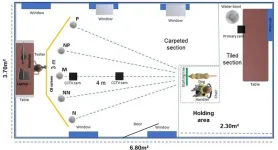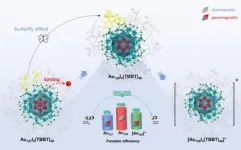EMBARGOED FOR RELEASE UNTIL 4:00 P.M. ET, WEDNESDAY, APRIL 9, 2025
MINNEAPOLIS — While some studies have suggested that having a mother with Alzheimer’s disease may put you more at risk of developing the disease, a new study finds that having a father with the disease may be tied to a greater spread of the tau protein in the brain that is a sign of the disease, according to a study published on April 9, 2025, online in Neurology®, the medical journal of the American Academy of Neurology. The study does not prove that having a father with Alzheimer’s results in these brain changes; it only shows an association.
The study also showed that female participants may be more at risk of a heavier buildup of tau protein than male participants.
“We were surprised to see that people with a father with Alzheimer’s were more vulnerable to the spread of tau in the brain, as we had hypothesized that we would see more brain changes in people with affected mothers,” said study author Sylvia Villeneuve, PhD, of McGill University in Montreal, Canada.
The study looked at 243 people who had a family history of Alzheimer’s disease but had no thinking or memory problems themselves at the average age of 68. Family history was defined as one or both parents with the disease or at least two siblings with the disease. Participants had brain scans and took tests of thinking and memory skills at the start of the study and then during the study as they were followed for an average of nearly seven years.
During that time, 71 people developed mild cognitive impairment, which is a precursor to Alzheimer’s disease.
Researchers found that people with a father with Alzheimer’s disease as well as female participants had a greater spread of tau protein in the brain. Female participants also had a heavier buildup of tau protein in the brain.
“Better understanding these vulnerabilities could help us design personalized interventions to help protect against Alzheimer’s disease,” Villeneuve said.
A limitation of the study is that white people made up the majority of participants, so the results may not apply to other groups.
The study was supported by the Canadian Institutes of Health Research, Quebec Research Fund – Health, J.-Louis Lévesque Foundation, Brain Canada Foundation, Alzheimer’s Society Canada and Brain Canada Research.
Discover more about Alzheimer’s disease at BrainandLife.org, from the American Academy of Neurology. This resource also offers a magazine, podcast, and books that connect patients, caregivers and anyone interested in brain health with the most trusted information, straight from the world’s leading experts in brain health. Follow Brain & Life® on Facebook, X, and Instagram.
The American Academy of Neurology is the leading voice in brain health. As the world’s largest association of neurologists and neuroscience professionals with more than 40,000 members, the AAN provides access to the latest news, science and research affecting neurology for patients, caregivers, physicians and professionals alike. The AAN’s mission is to enhance member career fulfillment and promote brain health for all. A neurologist is a doctor who specializes in the diagnosis, care and treatment of brain, spinal cord and nervous system diseases such as Alzheimer's disease, stroke, concussion, epilepsy, Parkinson's disease, multiple sclerosis, headache and migraine.
Explore the latest in neurological disease and brain health, from the minds at the AAN at AAN.com or find us on Facebook, X, Instagram, LinkedIn, and YouTube.
END
Father with Alzheimer’s? You may be more at risk of brain changes
2025-04-09
(Press-News.org)
ELSE PRESS RELEASES FROM THIS DATE:
MSU research: Eating brown rice increases exposure to arsenic compared to white rice
2025-04-09
Why this matters:
Arsenic levels in brown rice were found to be higher for U.S. consumers than in white rice, despite people often looking to brown rice as a healthier alternative.
There is significant arsenic risk for U.S. children under 5 who consume brown rice, as arsenic is a toxic chemical element that can lead to health problems.
Arsenic levels in U.S.-grown rice were found to be considerably lower than rice grown outside the country, suggesting there is concern to U.S. consumers who eat rice grown outside the country.
EAST LANSING, Mich. – Whether you buy rice at the grocery store or order a side of it while ...
Do “optimistic” versus “pessimistic” medical detection dogs perform differently?
2025-04-09
A new, exploratory study has revealed statistical links between the performance of medical detection dogs and their scores on behavioral and affective tests, finding that more “optimistic” dogs tended to perform better overall on detection tasks, but “pessimistic” dogs had higher scent detection specificity. Sharyn Bistre Dabbah of the University of Bristol, U.K., and colleagues present these findings in the open-access journal PLOS One on April 9, 2025.
Animal researchers commonly use a method called judgment bias testing to help assess animals’ emotional states. For example, dogs may first be trained to associate a specific location in a room ...
Multi-virus wastewater surveillance shows promise at smaller, site-specific scales
2025-04-09
In a new study, wastewater surveillance for multiple pathogens at five different sites identified local trends that were not captured in larger surveillance programs, and some sites used the data to inform efforts to prevent disease spread. Jay Bullen of Untap Health in London, U.K., Charlotte Hammer of the University of Cambridge and colleagues present these findings in the open-access journal PLOS Global Public Health.
People with viral infections produce waste containing viral RNA that ends up in wastewater ...
In addition to participation in school-based extracurricular activities, U.S. adolescents who participate in faith-based or community-based extracurricular activities may be more likely to identify th
2025-04-09
Scientists from Yale University report that in addition to participation in school-based extracurricular activities, U.S. adolescents who participate in faith-based or community-based extracurricular activities may be more likely to identify the risks of binge-drinking behavior, which could be an important consideration when developing preventions for excessive alcohol consumption.
###
Article URL: https://plos.io/4jHh7Dd
Article Title: Adolescent extracurricular activities and perception of risk of harm from binge drinking
Author Countries: United States
Funding: This study was financially supported by the National Institute on Drug Abuse (NIDA) (https://nida.nih.gov) ...
A new smartphone-sized device can test for tuberculosis. Here’s why that matters for children
2025-04-09
Tulane University researchers have developed a first-of-its-kind handheld diagnostic device that can deliver rapid, accurate tuberculosis diagnoses in under an hour, according to a study published in Science Translational Medicine.
The smartphone-sized, battery-powered lab-in-tube assay (LIT) provides a cost-effective tool that can improve TB diagnoses, particularly in resource-limited rural areas where health care facilities and lab equipment are less accessible. Over 90% of new TB cases occur in low- and middle-income countries.
This point-of-care device is the first to detect Mycobacterium tuberculosis (Mtb) DNA in saliva, in addition to blood and sputum samples. Saliva is ...
Scientists uncover spin–catalytic activity correlation in single-atom and -electron tailored gold nanoclusters
2025-04-09
Recently, a team of researchers from the Hefei Institutes of Physical Science of the Chinese Academy of Sciences (CAS) has consecutively removed the innermost atom and the outermost electron of a gold nanoparticle—without disturbing its overall structure. This precise manipulation allowed them to probe how the magnetic spin of the material influences its catalytic activity.
The work, led by Prof. WU Zhikun in collaboration with Prof. YANG from the Institute of Process Engineering, CAS and Prof. TANG from Chongqing University, ...
New research further translates the language of the genome
2025-04-09
New research has uncovered more about the complexity of human gene regulation by identifying certain sequences of proteins called transcription factors that bind to DNA and regulate the expression of human genes.
Published today (9 April) in Nature, researchers from the Wellcome Sanger Institute, the University of Cambridge and their collaborators explored how DNA-guided transcription factors interact with each other.
This research adds to the groundwork of understanding the complex language of the gene regulatory code, and how DNA sequence patterns located close to our genes influence human development and disease risk.
Each ...
How much food can the world grow? International team calls for new yield potential estimates
2025-04-09
An international team of agronomists is calling for a new approach to estimate crop yield potential and gaps — information that is critical in planning how to meet growing food demand.
University of Nebraska–Lincoln researchers made major contributions to the study, published online April 8 in the journal Nature Food.
“We are in a race to feed the world and to try to feed the population with the available agricultural land that we have,” said Patricio Grassini, Sunkist Distinguished Professor of Agronomy and one of the paper’s authors.
To ...
Could LLMs help design our next medicines and materials?
2025-04-09
CAMBRIDGE, MA – The process of discovering molecules that have the properties needed to create new medicines and materials is cumbersome and expensive, consuming vast computational resources and months of human labor to narrow down the enormous space of potential candidates.
Large language models (LLMs) like ChatGPT could streamline this process, but enabling an LLM to understand and reason about the atoms and bonds that form a molecule, the same way it does with words that form sentences, has presented a scientific stumbling block.
Researchers ...
Advanced genome sequencing enables genetic diagnosis for complex psychiatric conditions
2025-04-09
San Diego—April 9, 2025– In a manuscript published today in the American Journal of Psychiatry titled Long-Read Genome Sequencing in Clinical Psychiatry: RFX3 Haploinsufficiency in a Hospitalized Adolescent With Autism, Intellectual Disability, and Behavioral Decompensation, authors describe how they leveraged long-read genomic sequencing (LRS) to make a genetic diagnosis in a17-year-old male with autism spectrum disorder, intellectual disability, and acute behavioral decompensation that would not have been possible by standard methods. Through the use of LRS, a cutting-edge technology ...



